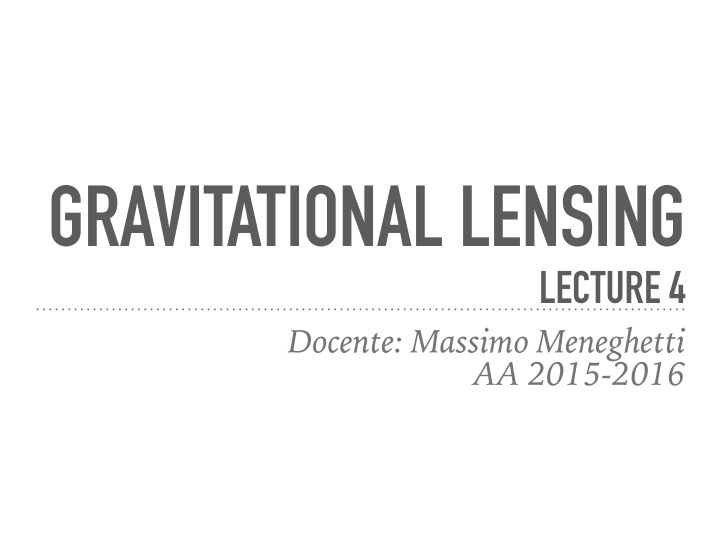



GRAVITATIONAL LENSING LECTURE 4 Docente: Massimo Meneghetti AA 2015-2016
CONTENTS ➤ Distortion and magnification (continuation) ➤ Second order lensing: flexion ➤ Time delays
EXAMPLE: FIRST ORDER DISTORTION OF A CIRCULAR SOURCE β 2 1 + β 2 2 = β 2 In the reference frame where A is diagonal: ✓ ◆ ✓ ◆ ✓ ◆ β 1 1 − κ − γ θ 1 0 = β 2 1 − κ + γ θ 2 0 = (1 − κ − γ ) θ 1 β 1 = (1 − κ + γ ) θ 2 β 2 β 2 = β 2 1 + β 2 2 = (1 − κ − γ ) 2 θ 2 1 + (1 − κ + γ ) 2 θ 2 2 This is the equation of an ellipse with semi-axes: β β b = a = 1 − κ − γ 1 − κ + γ
EXAMPLE: FIRST ORDER DISTORTION OF A CIRCULAR SOURCE convergence : responsible for isotropic expansion or contraction shear : responsible for anisotropic distortion e = a − b γ Ellipticity: 1 − κ = g a + b =
EXAMPLE: FIRST ORDER DISTORTION OF A CIRCULAR SOURCE What is the orientation of the ellipse? Let’s find the eigenvectors corresponding to the eigenvalue λ t ✓ γ − γ 1 ◆ − γ 2 E λ t = N ( A − λ t I ) = = N γ + γ 1 − γ 2 γ 2 Result: with v = ( v 1 , v 2 ) = | v | (cos � 0 , sin � 0 ) ~ v 1 = v 2 γ − γ 1 After some math: cos φ 0 = ± cos φ φ 0 = φ φ 0 = φ + π
SHEAR DISTORTIONS γ 2 γ 1
MAGNIFICATION Kneib & Natarajan (2012)
MAGNIFICATION dS Kneib & Natarajan (2012)
MAGNIFICATION dS dI Kneib & Natarajan (2012)
MAGNIFICATION dS dI Kneib & Natarajan (2012)
CONSERVATION OF SURFACE BRIGHTNESS The source surface dE I ν = brightness is dtdAd Ω d ν In phase space, the radiation emitted is characterized by the density dN f ( ~ p, t ) = x, ~ d 3 xd 3 p In absence of photon creations or absorptions, f is conserved (Liouville theorem) dN = dE h ν = dE dN dE I ν f ( ~ p, t ) = d 3 xd 3 p = hcp 3 dAdtd ⌫ d Ω = x, ~ cp hcp 3 Since GL does not involve creation or d 3 x = cdtdA absorption of photons, neither it changes the photon momenta (achromatic!), surface d 3 ~ p = p 2 dpd Ω brightness is conserved!
MAGNIFICATION Kneib & Natarajan (2012) Z Z I ν ( ~ ν [ ~ � ( ~ I S ✓ ) d 2 ✓ = ✓ )] µd 2 � F ν = I S Lensing changes the amount of photons (flux) we receive from the source by changing the solid angle the source subtends
MAGNIFICATION dS Kneib & Natarajan (2012) Z Z I ν ( ~ ν [ ~ � ( ~ I S ✓ ) d 2 ✓ = ✓ )] µd 2 � F ν = I S Lensing changes the amount of photons (flux) we receive from the source by changing the solid angle the source subtends
MAGNIFICATION dS dI Kneib & Natarajan (2012) Z Z I ν ( ~ ν [ ~ � ( ~ I S ✓ ) d 2 ✓ = ✓ )] µd 2 � F ν = I S Lensing changes the amount of photons (flux) we receive from the source by changing the solid angle the source subtends
MAGNIFICATION dS dI Kneib & Natarajan (2012) Z Z I ν ( ~ ν [ ~ � ( ~ I S ✓ ) d 2 ✓ = ✓ )] µd 2 � F ν = I S Lensing changes the amount of photons (flux) we receive from the source by changing the solid angle the source subtends
CRITICAL LINES AND CAUSTICS Both convergence and shear are functions of position on the lens plane: = ( ~ ✓ ) � = � ( ~ ✓ ) The determinant of the lensing Jacobian is det A = (1 − κ − γ )(1 − κ + γ ) = µ − 1 The critical lines are the lines where the eigenvalues of the Jacobian are zero: tangential critical line radial critical line Along these lines the magnification diverges! Via the lens equations, they are mapped into the caustics …
SECOND ORDER LENS EQUATION A ij
SECOND ORDER LENS EQUATION ∂ A ij A ij = D ijk ∂θ k
SECOND ORDER LENS EQUATION ∂ A ij A ij = D ijk ∂θ k
SECOND ORDER LENS EQUATION ∂ A ij A ij = D ijk ∂θ k
Recommend
More recommend